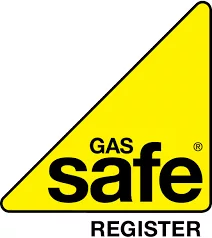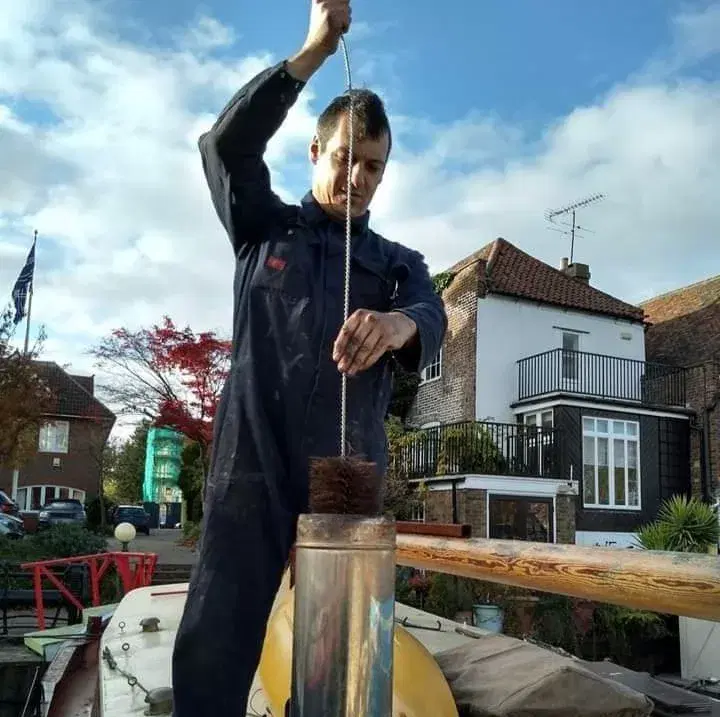Boat stove safety is a critical issue for anyone living on the UK’s inland waterways. At Marine Heating Solutions, we work on vessels nationwide, and recently, we have encountered installations in shockingly dangerous condition. From cracked stove bodies to DIY flues, many pose a severe risk of fire or Carbon Monoxide (CO) poisoning.
This guide provides the essential 2025/2026 standards for stove safety, adhering to Boat Safety Scheme (BSS) guidelines and the latest EcoDesign requirements.
1. The Hearth: Your First Line of Defence
A hearth isn’t just a decorative base; it is a thermal barrier. Construction must use non-combustible materials (tiles, sheet metal, or stone) and meet specific distance requirements to prevent heat transfer to the boat’s structure:
- Manufacturer Specs: Always check your manual. Many modern stoves require a 30mm thick non-flammable base or a 50mm air gap below the stove to protect the floor.
- Hearth Dimensions: Unless specified otherwise, hearth bases should extend at least 150mm to the sides and back, and 225mm to the front of the appliance.
- Heath Shielding: Walls behind and to the sides of the stove should be fitted with 25mm fire boards, leaving a 10mm air gap behind the board to prevent heat from reaching the boat’s timber lining.
Pro-Tip: If your boat’s layout doesn’t allow for a traditional hearth, we recommend the Go Eco Adventurer 5. It features built-in heat shielding, making it inherently safe for tight spaces. View our Free Installation Offer on this and other stoves.
2. The Flue: Say Goodbye to Single-Skin Steel
Traditionally, boat flues were single-skin mild steel, but these are prone to internal rusting and “cold gas” backdrafts that can draw gases back into the cabin.
- The Modern Standard: We install Stainless Steel Twin-Wall Insulated Flues. These keep the smoke hot, ensuring it rises quickly and safely out of the cabin, while resisting corrosion.
- Length Matters: Many domestic stoves require a 4.5-metre flue to draw correctly—a height that most boats simply don’t have. Using an unsuitable stove with a short flue can lead to life-threatening CO buildup.
- Maintenance: Flues should be swept regularly. We recommend a professional sweep at least once a month if you are running the stove daily.
3. EcoDesign & Smoke Control (2025/2026 Updates)
As of January 2025, new non-EcoDesign wood-burning stoves are no longer legal to install in many UK settings. Furthermore, Smoke Control Areas have expanded in 2025 and 2026 to include moored vessels in several major UK cities. You can check the latest local restrictions on the UK Government Smoke Control Area map to see if your mooring is affected.
- New Installations: If you are fitting a new stove, it must be EcoDesign compliant to meet modern emission and efficiency standards.
- Performance: EcoDesign stoves can reduce fuel consumption by up to 50% compared to older models.
4. General Condition & Total Ventilation Requirements
Every solid fuel or diesel stove requires a constant, fresh air supply to burn safely and prevent the buildup of deadly gases. However, calculating safety isn’t just about the stove; it’s about the total air demand of the entire vessel.
The BSS Ventilation Formula
To ensure your cabin has enough fixed (non-closeable) ventilation, we use the following British Standard calculation:
V = [2200 \times U] + [650 \times P] + [550 \times H] + [440 \times F]
- U: Total kW of unflued appliances (e.g., gas hobs).
- P: Number of people/berths the boat is designed for.1
- H: kW output of open-flued solid fuel stoves.
- F: kW input of open-flued gas/liquid heaters (e.g., boilers).
Critical Safety Checks
- Cumulative Airflow: This calculation accounts for everyone on board and all air-consuming appliances. If you add a new stove, your existing mushroom vents or louvres may no longer be sufficient.
- Fixed Vents Only: Only vents that cannot be closed (without tools) count toward this safety total.
- Stove Health: Inspect your stove body annually for cracks or structural damage. Door seals must be airtight; a failing seal can lead to “over-firing” and carbon monoxide leakage.
Expert Resource: For the full technical breakdown, refer to the BSS Essential Guide Chapter 8: Appliances and Flues (opens in a new tab) or visit HETAS Advice for Consumers (opens in a new tab) for solid fuel best practices.
Are You Protected?
Never light a stove without functioning Carbon Monoxide and smoke alarms. In 2025, ensure your CO alarm is certified specifically for marine use (BS EN 50291-2).
Is your stove showing signs of age? We offer a Marine Appliance Refurbishment Service that can restore your stove to peak safety without the cost of a full replacement.







5 comments
Comments are closed.